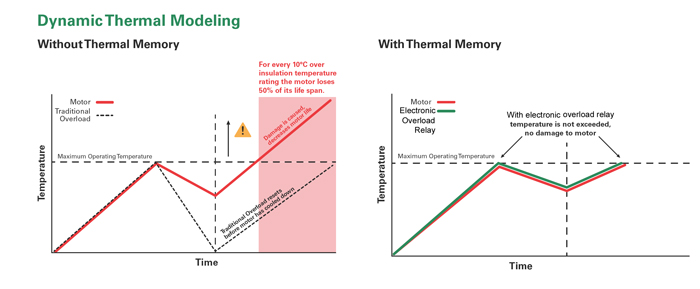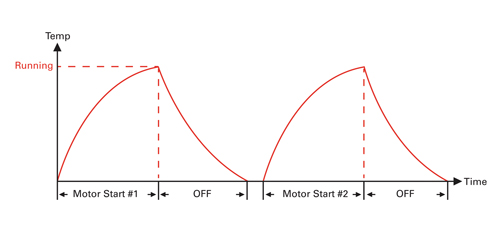When can you trust your overload relay to keep you safe?
The oil and gas industry depends heavily on pumps, and their reliability is vital for safety and economic reasons. For many years, the low-voltage motors used to power pumps (480 volts, less than 100 or 150 horsepower) have been protected from overheating by thermal overload relays. These relays may not provide proper protection under all conditions, which can lead to motor failure and potential safety issues.
This article explains the differences between electromechanical and electronic overload relays and shows how the latter can provide better motor protection and increase safety. It also explains how an electronic relay provides information about the health of a pump or motor that can be used to predict problems more accurately and earlier, before they become safety problems.
Electrical Causes of Motor Failure
According to Electrical Research Associates (ERA) almost half of all motor failures are caused by electrical problems. Below are the leading causes of such damage:
Overload—The most common electrical problem causing motor failure is overload, which leads to overheating. This eventually breaks down the winding insulation and causes a short circuit.
Jam—The motor's load can jam, causing a locked-rotor condition, which will quickly overheat the motor.
Phase imbalance—One phase of the input can fail (a single-phasing condition), causing overheating and loss of torque. More subtly, the voltage on one phase can be less than the others (phase imbalance), which has similar results but is more difficult to diagnose.
Ground fault—The motor may develop a ground fault, which can cause anything from an arc to a dead short circuit to a small current that never goes away. This can cause shock hazards, fires or even arc flash.

Figure 2. A thermal overload cools down faster than a motor, which can cause it to fail to trip if an overload happens in several stages. The dynamic thermal model in an electronic overload relay more accurately tracks motor temperature and will trip before damage occurs.
Types of Overload Relays
To prevent damage, motors are equipped with overload relays, which are designed to shut off power to the motor before damage can occur. These come in two major types: thermal (electromechanical) overload relays and electronic (microprocessor-based) overload relays.
Traditional thermal overloads are electromechanical devices that include bimetallic or melted alloy (eutectic) overloads. They contain heating elements wired in series with the motor inputs that cause either a pool of solder (eutectic alloy) to melt or a set of bimetallic strips to bend and release the contacts when the current becomes excessive. Bimetallic overloads generally have a limited range of adjustable trip points, while eutectic relays do not.
Some bimetallic overloads are designed to reclose automatically and are compensated to prevent ambient temperature changes from affecting their trip points. Ideally, a thermal overload should be installed in the same ambient temperature as the motor it protects, but in practice, the device is in the motor starter, which is usually in an air-conditioned switchgear room away from the motor.
Solid state overloads were later introduced to resolve the inaccuracies of thermal-based overloads. However, they have pre-calculated setpoints and cannot provide the same level of protection as microprocessor-based (electronic) overloads, such as detecting single-phase or unbalance conditions.
Electronic overloads (Figure 1) measure current using a set of (often integral) current transformers. They also monitor for ground faults and perform several more advanced functions, including protections against phase loss, phase imbalance, improper phase sequence and jams. These devices can be simple or quite sophisticated, depending on the operator needs, and can include additional features such as communications, digital readouts and data logging capabilities.
Unlike electromechanical relays, which pass motor current through heating elements to provide an indirect imitation of motor heating, electronic relays do not cause excess heating. This saves on the electric bill (the heat dissipation consumes power, after all), while the lack of heat generation keeps power panels cooler and provides for more accurate measurements. In addition, bimetallic overloads can generate enough heat to necessitate panel derating or the need to use a larger enclosure to allow adequate space for heat dissipation.
Features of Electronic Overload Relays
Electronic overloads have features that are especially relevant to the oil and gas industry and can help improve safety by detecting potential problems before damage occurs.
Undercurrent
Some electronic overloads are designed to sense when the load current drops below normal levels. This is especially useful in pump applications, where a loss of fluid can cause damage. Submerged pumps, for example, can overheat or be damaged in other ways if they run dry.
Low-level sensors are traditionally used in these cases, but they often fail and are difficult to maintain. Often the sensors are not functioning properly and no one is aware of the problem, leaving the pump unprotected.
Ground Faults
Conventional electromechanical overloads cannot detect ground faults, but electronic overloads can and alert operators and shut down motors before the damage spreads. A leading insurance company has reported that each claim in manufacturing that was a result of an electrical problem costs approximately $769,000, and it has been estimated that about 95 percent of all electrical problems start out as ground faults.
Thermal Memory
In a thermal-based motor-overload relay, the internal heat elements are designed to mimic the motor heating characteristics. Unfortunately, the accuracy of this model is limited. Electronic overload relays employ more sophisticated dynamic thermal modeling. The unit's internal computer uses all the data available to it (including the output from the motor's winding temperature sensor) to construct a highly accurate computer model of the motor's thermal characteristics. It keeps track of the motor's used I2t to calculate motor temperature and thermal capacity more accurately than winding temperature sensors alone, and it calculates the temperature of the motor under all operating conditions.
When current exceeds the trip point of a thermal-based electromechanical relay, it will heat up the internal element, causing it to melt or bend to trip (Figure 2). After that, both the electromechanical overload and the motor begin to cool, but the thermal overload cools and resets at a faster rate than the motor. This allows operators to restart the motor before it has fully cooled off.
The overload condition resumes before the overload trips, causing motor damage and exposing operators to the risk of fire or electric shock. In contrast, an electronic overload relay with a dynamic thermal model can accurately calculate motor temperature and will trip in time to protect the motor.
The electronic overload relay can also prevent premature restarts. When a motor is stopped after it has reached thermal equilibrium (Time 1 in Figure 3), it takes a certain amount of time to cool down. Restarting after cool-down causes no harm. Since a standard thermal overload tends to cool off more quickly than the motor, it can allow the operator to restart the motor while it is still hot, which can quickly burn it out. The dynamic thermal model predicts the true temperature of the motor and lets the operator know when it is safe to restart it.
Low Maintenance
Electromechanical thermal-based overloads require a certain amount of maintenance to ensure proper operation. Unfortunately, they often do not get it. For example, if one of the internal heat elements on a thermal overload fails, then all three should be replaced (being sure to use elements with the same ratings as the original), but this may not always be done. In addition, each time a bimetallic overload trips, its setpoint tends to shift slightly, After a certain number of trips, it should be replaced. Again, this may not always be done.
More significantly, if a short circuit event downstream of the overload (one that trips the breaker or opens the fuse in the feeder panel) occurs, manufacturers recommend changing the electromechanical overloads, even if they appear to be undamaged, as internal elements may be damaged by the high level of short circuit current that goes through them. Such replacement may not be done. The short circuit event has no effect on an electronic overload relay.
Phase Loss and Phase Imbalance
When power to one phase of a motor is lost, the current in the remaining two phases increases—by 1.73 times if the motor is fully loaded. A conventional electromechanical overload relay will trip under these conditions but only after a delay of 35 seconds or more. This delay occurs because the relay cannot differentiate between a 73 percent overload on one phase and a normal starting load or load increase, which it is designed specifically to ignore. An electronic overload relay, on the other hand, can recognize the problem immediately and respond.
When the voltage on one phase of a motor is less than the others (usually caused by an upstream single phase load) the currents in the other two phases increase and cause the motor temperature to rise, which may require that the motor load be reduced. This phase imbalance (which may be on the order of 5 percent) will in all likelihood be completely invisible to an electromechanical overload, whereas a microprocessor-based relay can respond immediately.
Setting Accuracy
The set point of an electronic overload is entered digitally; both bimetallic and electronic overloads have adjustable trip points, but some electronic overload relays are available with password protection for settings that can keep operators or other unauthorized people from changing a trip point and allowing a motor to be run to destruction.
Remote Reset
Both thermal and electronic overload relays are available with optional remote reset capability that can be mounted on the front panel of the electrical box. This is important as it eliminates the need to open the power panel, which can expose the operator to possible electric shock.
In some cases, regulations may require the use of personal protective equipment to guard against arc flash. In addition, many electronic overload relays have remote operator interface panels that show current and other variables during operation and, after a trip, show the operator at a glance what caused it. This allows operators to take safety precautions to eliminate the problem from occurring or prevent it from becoming a major safety issue.
Communications
Electronic overload relays have digital communication capabilities that provide a wealth of information to remote displays or asset management systems. Real-time monitoring is today's preventive maintenance. Trends in motor current and temperature over time can aid predictive maintenance programs in preventing equipment failure, unscheduled downtime—which can reach $1 million per day in a refinery—or fires. The trending of the electrical parameters is used to monitor mechanical performance, which reduces costs as well as increases the safety of operators.

Figure 3. With a conventional thermal overload, it is necessary to allow for more motor cooling between restarts.
Summary
While electromechanical overloads have been used in the oil and gas industry for many years, more modern electronic units not only provide better motor protection, they can increase safety and integrate well with today's asset management systems to help predict problems and prevent plant downtime.
Tony Locker, P.E. is product manager for protective relay systems at Littelfuse POWR-GARD. He holds a BSEE from the Rose-Hulman Institute of Technology, an MSEE from Georgia Institute of Technology and two patents. His background includes leading design teams and managing control and power system installations.
Pumps & Systems, April 2011


